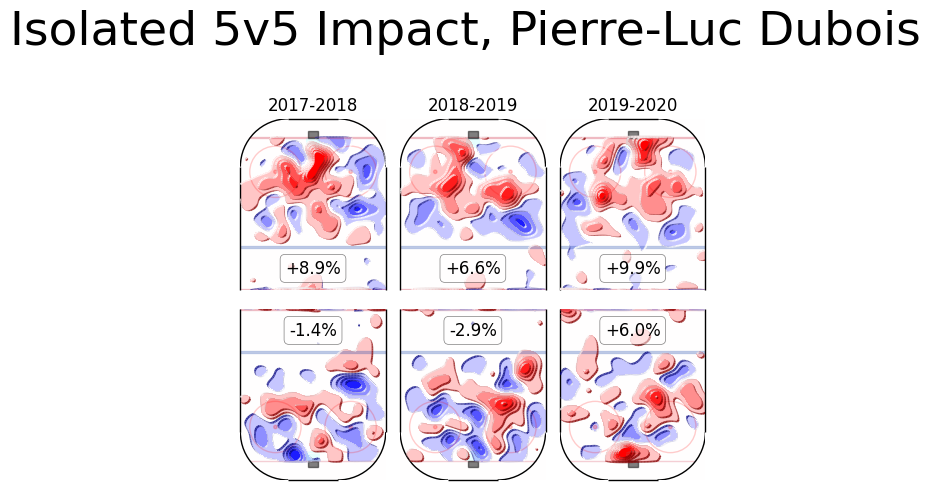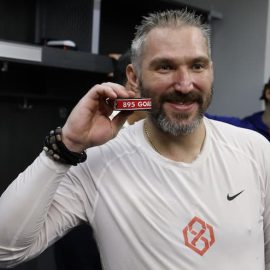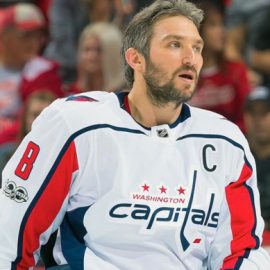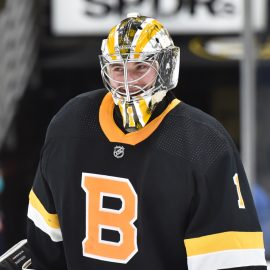Having spent the better part of the last two and a half years tearing down their roster in the pursuit of draft picks and young depth, only one significant question remains.
Who will be the Ottawa Senators’ number one centre?
Looking around the league at successful franchises who have enjoyed extended windows of contention, it is impossible to ignore the fact that these teams employ impactful first-line centres.
Over the last 15 to 20 years, centres like Brayden Point, Ryan O’Reilly, Nicklas Backstrom, Sidney Crosby, Evgeni Malkin, Anze Kopitar, Jonathan Toews, Patrice Bergeron, Pavel Datsyuk, Eric Staal, Vincent Lecavalier and Ryan Getzlaf have helped their teams lift the Stanley Cup.
This is not meant to understate the importance of the quality of depth surrounding these aforementioned players, but the point remains: if an organization does not have an impactful centre who can be productive in tough minutes and contribute at both ends of the ice to help drive the transition game, it will be very difficult to win a Stanley Cup.
In the early to mid 2000’s, the heyday of the Senators franchise, the strength of the team lied in its blue line and the quality of its wingers. Centres like Radek Bonk, Mike Fisher, Todd White, Bryan Smolinski or the litany of fourth line options that they rolled out were fine. None of them could ever be mistaken for a bonafide number one centre however.
Alexei Yashin and Jason Spezza were franchise guys, but one was too selfish and flawed to carry his team. The other simply arrive too late to the parent roster to push the team’s core over the top. By the time Spezza became an impactful centre, the rest of Ottawa’s core from the early 2000’s was slowly getting pushed out as they became more expensive.
Had Spezza’s career arrived two to three years earlier, I don’t think there’s any question that the Senators would have won a Stanley Cup.
Shifting the focus to the present, for this rebuild to be successful, the Ottawa Senators will need a number one centre.
Tim Stützle may ultimately wind up being the guy who assumes that role.
Stützle has scored five goals and 10 points. His play has singlehandedly reinvigorated this fan base with an exceptional performance through Germany’s first four games at this year’s World Junior Championships. Along with J.J. Peterka and Florian Elias, Stützle has anchored the first line and helped carry the undermanned German roster to its first quarterfinal appearance in the tournament’s history.
It is a remarkable accomplishment for the 2020 NHL Draft’s third overall pick, but when he eventually arrives in Ottawa, he will start his NHL career on the left wing.
Although he is a natural centre, the Senators are going to shelter Stützle’s responsibilities in his professional season in North America. In saying that, there does not appear to be a clear scouting consensus on where Stützle’s long-term positional outlook is. He could ultimately become a centre where his speed and playmaking skills will play up or he could find himself at left wing where the pressures of developing into a two-way talent will be smaller.
If Stützle does not become that guy, there is not really anyone in the Senators’ system who safely projects as someone who can shoulder that responsibility. Logan Brown, Josh Norris and Shane Pinto are prospects who are likely best suited for the second or third line centre roles.
Which means that the Senators’ only opportunity if they are unsure of Stützle’s ability to play centre at the NHL level, they will either have to draft another centre or go out and trade for one.
Point projections for the Senators in this shortened 2020-21 season are not particularly high. Most pundits and analysts believe the Senators are likely to finish at the bottom of the competitive North Division. With another earmarked lottery pick in their future, there appears to be a good chance that the team will have an opportunity to add another top prospect to its ranks.
Unfortunately in this scenario, not only will the Senators have to be bad, they will also have to be lucky and rely on the ping pong balls landing in their favour. Furthermore, early mocks of the 2021 NHL Draft project a class that should be dominated by defencemen going early and often in the top-10.
There’s no question the Senators would benefit by adding another right-shot defenceman to their mix if the likelihood of adding a first-line centre isn’t available with their first round selection in 2021. But, if the Senators cannot land a centre in the draft, they are going to have to look outside the organization to bring one into the fold.
Pierre-Luc Dubois is not in Columbus as camp approaches and remains unsigned. And now there are rumblings from a few teams around the league that Dubois may be looking for a change of scenery. Maybe wishful thinking on their part. But stay tuned on this one.
— Pierre LeBrun (@PierreVLeBrun) December 31, 2020
Shortly after Pierre LeBrun’s tweet yesterday, the Blue Jackets announced that they had inked Dubois to a two-year bridge deal worth an average of $5 million per season. The contract will pay him $3.35 million in the first year before escalating to $6.65 million next season.
Despite this new agreement, The Athletic‘s (paywall) Aaron Portzline believes that Dubois’ desire for a trade still exists.
Dubois’ agent, Pat Brisson, refused to comment on the rumours that his client wishes to be traded, but as Portzline reports, the short-term deal Dubois signed provides some advantages.
“The Blue Jackets may have been willing to sign Dubois to a long-term contract that would have reached into his unrestricted free agency seasons, but apparently a short-term “bridge contract” was preferred by Dubois’ camp for two reasons: (1) It gives Kekalainen time to seek a trade for Dubois and get a return that is commensurate with his value, rather than force an immediate trade. (2) It keeps Dubois from being locked in with Columbus long-term.”
Ottawa is in a pretty unique situation.
Shedding redundant veterans like Derek Stepan, Artem Anisimov, Cedric Paquette, Alex Galchenyuk, Erik Gudbranson, Braydon Coburn and Mike Reilly will free up $20.95 million in cap space (and $13.8 million in total salary). The contributions of these veterans should be replaced by inexpensive depth that the organization has developed internally.
According to CapFriendly.com‘s data, the Senators have 23 standard player contracts on the books for next season totaling approximately $44 million in projected cap costs and real estimated salary.
The flat cap and the modest cap gains that are anticipated over the next few years means that the Senators have a really important advantage. They are one of the few teams that has the cap space and trade capital to pull the trigger on a Dubois deal.
Dubois has the size and skill to be a legitimate first-line centre on a good team.
After posting two 20-plus goal seasons in his first two years in the league, the 22-year old from Ste-Agathe-Des-Monts, Quebec saw his production dip to 18 goals and 49 points in last year’s Covid-19 shortened campaign. In the postseason however, Dubois impressed helping his underdog Jackets knock off the Toronto Maple Leafs. Dubois finished the postseason with four goals and 10 points in 10 games.
In every season, the Blue Jackets have done fairly well by shot and goal metric standards when Dubois has been on the ice at five-on-five.
The following chart is from NaturalStatTrick.com‘s data:
| Season | CF% | SF% | SCF% | GF% | xGF% |
| 2017-18 | 55.64 | 54.73 | 55.05 | 53.85 | 55.08 |
| 2018-19 | 52.27 | 52.69 | 54.54 | 58.46 | 53.71 |
| 2019-20 | 51.11 | 52.12 | 53.63 | 51.22 | 54.27 |
It is worth mentioning that in Dubois’ first two seasons, the centre played almost exclusively with Artemi Panarin at five-on-five. Playing alongside one of the best and most productive wingers in hockey is inevitably going to spike a player’s production and help his underlying numbers.
According to Evolving-Hockey.com’s ‘wins above replacement’ (WAR) and ‘goals above replacement’ (GAR), Dubois’ been a positively valuable player in each season he has played in.
Dubois’ most productive campaign was his 2018-19 season in which he scored 27 goals and 61 points. At five-on-five that season, he scored 2.22 points per 60. Without Panarin last season however, Dubois’ numbers didn’t experience that much of a drop. At five-on-five, he produced the second-highest points per 60 rate of his career at 2.01 while producing the lowest second-assist rate of his career (0.49). In other words, Dubois was involved principally in a lot of the Columbus’ goals.
That is pretty encouraging for any general manager who is trying to acquire him and for a team like the Senators that could potentially have one of Brady Tkachuk or Tim Stützle line up alongside Dubois, the Senators have some intriguing options to use.
Most importantly, Pierre-Luc Dubois is a transitional wizard. His ability to navigate through the neutral zone and gain entry with possession of the puck would be such a welcomed addition to the Senators’ lineup.
var divElement = document.getElementById(‘viz1609525718724’); var vizElement = divElement.getElementsByTagName(‘object’)[0]; vizElement.style.width=’100%’;vizElement.style.height=(divElement.offsetWidth*0.75)+’px’; var scriptElement = document.createElement(‘script’); scriptElement.src = ‘https://public.tableau.com/javascripts/api/viz_v1.js’; vizElement.parentNode.insertBefore(scriptElement, vizElement);
On the defensive side of the puck, HockeyViz.com‘s data helps show that he has been a decent defender in the past.
In Dubois’ first two years in the league, he had a positive isolated impact in the offensive (+ is good) and defensive (- is good) zones. While last year represented a negative swing in his defensive impact, there is enough history and tools under the hood to believe that he can be better.
So ultimately, the question becomes: what opportunity cost will be needed to acquire Dubois?
Looking at Columbus’ roster, the first thing that really strikes me is how deceivingly old the core of their team is. With the exceptions of Dubois or Zach Werenski, the bulk of the core is aged 26 to 32 years of age. Looking at the composition of their roster and a prospect pool that The Athletic’s Corey Pronman ranked 19th out of the 31 teams (paywall) , their competitive window to make any noise should theoretically be now.
The problem with Columbus is that they are a bit of a tweener team. They are competitive enough to reach the postseason, but not competitive enough to have any sustainable success. They are simply one of those teams that is too to avoid the draft lottery, but not good enough to be considered a contender. They are in that weird middle ground that Ottawa was stuck in for a number of years and it makes it more difficult to find game-breaking talent when you’re drafting in the middle of the first round.
If Dubois’ desire to leave is real, the Senators have a real opportunity here.
As I mentioned earlier, the Senators have the trade capital to spare.
In the same article that I referred to earlier, Corey Pronman ranked the Senators as having the third-best farm system in the league.
They have depth at every position, but if there is a knock to their system, aside from Stützle, the organization simply lacks having enough highly projectable and safe upside talent. Adding Dubois would help mask that shortcoming.
Looking at the left defence position, you wonder whether a package could be built around Erik Brannstrom.
As welcomed as it would be for Brannstrom to have a sensational season and supplant one of the veterans on the roster (Coburn, Reilly or even Wolanin), what does the future hold for a player who the organization believes needs to play on his natural side and seems destined to play behind Thomas Chabot and eventually Jake Sanderson?
In July, The Athletic‘s Scott Wheeler had Brannstrom ranked as his 19th best prospect (paywall). This ranking was from July and obviously took place ahead of the 2020 NHL Draft, but it still exemplifies how well-regarded Brannstrom is in the eyes of the scouting community. He is the prototypical puck-moving, offensive defenceman that defines the modern era and in Ottawa, he may have more value as a trade chip than he would as a third-pairing defenceman.
Pierre Dorion can build a package around Brannstrom and supplement it with one of Ottawa’s young centres. The depth at the centre position with Colin White, Logan Brown, Josh Norris, Shane Pinto and Ridley Greig should afford the organization the comfort to deal from this position of strength.
Armed with two first-round picks and four-second round picks (which could have been five if not for the Stepan trade) combined over the next two drafts, the Senators could easily lottery protect one of their future firsts or use some combination of seconds to push their offer over the top. Even including a prospect who may have lost some of their luster like Lassi Thomson should be considered.
If the Senators are genuine with their intent to spend to the cap and enjoy five-years of unparalleled success, they are going to need a number one centre and if Dubois is available, he could be the right fit for them.
Add The Sports Daily to your Google News Feed!








